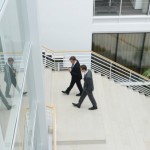Agile Leadership

The Appleton Greene Corporate Training Program (CTP) for Agile Leadership is provided by Mr. Zambrano Certified Learning Provider (CLP). Program Specifications: Monthly cost USD$2,500.00; Monthly Workshops 6 hours; Monthly Support 4 hours; Program Duration 12 months; Program orders subject to ongoing availability.

Personal Profile
In the dynamic realm of business consultancy, Mr. Zambrano has played a pivotal role in driving transformative initiatives at Garrick Solutions. His collaborative approach shines through as he provides transformative energy and solutions for businesses to leverage technology for an exponential level of growth.
Through one of his engagements, he has designed automation systems, enhancing client engagement for a Morgan Stanley family office, as well as fostering partnerships with inventory management software companies so they can leverage application heat maps to evaluate functional use from their employees and customers.
Collaborating with PWC consulting, he changed the mindset of simply cost cutting, but also to focus on understanding the company culture, and the leadership factors affecting the daily operations. With this mindset shift, PWC was able to adjust their change management strategy in order to better support their client’s leadership, and offer more attainable solutions, versus targeting initiatives that required support from external parties, additional investors, and external government entities and regulators.
A noteworthy accomplishment is the implementation of robotic process automation for invoice processing in a healthcare provider, with yearly revenue of over $25M, employing optical character recognition (OCR).
Taking on the role of Vice President at Avacore LLC, Mr. Zambrano not only managed daily operations for this commercial aftermarket aircraft parts broker, but also led a team dedicated to providing seamless 24/7 procurement support for global aircraft lessors during crucial aircraft transitions. His commitment to collaboration is evident in the implementation of quoting automations, ensuring rapid responses within 5 minutes of incoming quotes, 24/7. Embodying the mantra “do more with less,” Mr. Zambrano emphasizes finding alternative solutions to overcome financial or operational barriers, enabling small companies to compete with industry giants.
As the Co-Founder of a successful online marketplace platform, Mr. Zambrano ventured into the e-commerce landscape, breathing life into innovative concepts. Within a year, he successfully onboarded over 40 companies and 11.4k parts onto inventory. His strategic vision is underscored by trademarking a copyrighted robotic process automation designed for auditing and uploading product inventory. Leading a startup Mr. Zambrano had to effectively communicate and interact with several types of people, from investors, outsourced developers, customers, and employees. One of his most memorable moments is training a sales manager to become more confident in herself, and lead IT project initiatives for the growth of the company. This was a critical moment for Mr. Zambrano, as he saw more reward and value to help others grow and develop, more than for his own personal gain.
In his capacity as a Business Advisor at Jet Airways, Mr. Zambrano exhibited exceptional leadership, actively contributing to the company’s quest for improved profitability. His collaborative leadership style is evident in the management of a companywide cost benchmarking exercise with Seabury Aviation Group and the formalization of processes with the Indian Aviation Regulator (DGCA). Spearheading the implementation of the company’s Manual of Authority and Purchasing Manual, Mr. Zambrano demonstrated a commitment to structured growth. Notably, he optimized the B737 fleet plan, maintaining 70 aircraft throughout 2023, and identified substantial savings of $19 million in airport manpower operations. His decisive actions resulted in the reduction of 650 third-party employees and 136 internal staff, reflecting both leadership acumen and dedication to the company’s financial health and growth.
Mr. Zambrano also co-managed the implementation of the self-check in process for American Airlines across all international operations. One of his accomplishments was redesigning the entire check in process of American Airline’s Paris operations, which was the airline’s 2nd largest European hub. By collaborating with airport operations, airport security, and American Airlines station leadership, Mr. Zambrano changed the leadership’s approach to providing a higher level of customer service, leveraging technology, and reallocating shift managers to better address bottlenecks in the check-in process.
Mr. Zambrano is a forward-thinking and strategic leader with extensive experience in company management and technology-driven efficiency. His Yoda-like approach to leadership prioritizes wisdom and strategy over superhuman efforts.
Drawing on his diverse experiences in Colombia, the United Arab Emirates, India, and the United States, Mr. Zambrano excels in management consulting, optimizing client engagement, and streamlining business processes. His career is defined by a dedication to strategic thinking, fearless problem-solving, and a commitment to technology-driven efficiency. Both professionally and personally, Mr. Zambrano embodies an open-minded leadership style, constantly seeking ways to improve operations, think outside the box, and foster continuous growth.
To request further information about Mr. Zambrano through Appleton Greene, please Click Here.
(CLP) Programs
Appleton Greene corporate training programs are all process-driven. They are used as vehicles to implement tangible business processes within clients’ organizations, together with training, support and facilitation during the use of these processes. Corporate training programs are therefore implemented over a sustainable period of time, that is to say, between 1 year (incorporating 12 monthly workshops), and 4 years (incorporating 48 monthly workshops). Your program information guide will specify how long each program takes to complete. Each monthly workshop takes 6 hours to implement and can be undertaken either on the client’s premises, an Appleton Greene serviced office, or online via the internet. This enables clients to implement each part of their business process, before moving onto the next stage of the program and enables employees to plan their study time around their current work commitments. The result is far greater program benefit, over a more sustainable period of time and a significantly improved return on investment.
Appleton Greene uses standard and bespoke corporate training programs as vessels to transfer business process improvement knowledge into the heart of our clients’ organizations. Each individual program focuses upon the implementation of a specific business process, which enables clients to easily quantify their return on investment. There are hundreds of established Appleton Greene corporate training products now available to clients within customer services, e-business, finance, globalization, human resources, information technology, legal, management, marketing and production. It does not matter whether a client’s employees are located within one office, or an unlimited number of international offices, we can still bring them together to learn and implement specific business processes collectively. Our approach to global localization enables us to provide clients with a truly international service with that all important personal touch. Appleton Greene corporate training programs can be provided virtually or locally and they are all unique in that they individually focus upon a specific business function. All (CLP) programs are implemented over a sustainable period of time, usually between 1-4 years, incorporating 12-48 monthly workshops and professional support is consistently provided during this time by qualified learning providers and where appropriate, by Accredited Consultants.
Executive summary
Agile Leadership
The world today is greatly different from that of even 4-5 years ago. Technology has invaded all aspects of the world, with advancements driving an exponential level of growth.
As five generations are present in the workforce there is an increase of complexity for these generations to work together in organizations. Globalization has shifted workforce demographics, and with a decline in working age populations in advanced economies, worker’s expectations of the organizations they belonged to changed. Organizations need to do more to help improve individual’s lives, act in a more ethical manner, and go beyond a basic financial compensation to motivate its workforce.
image too small
With the drastic introduction of artificial intelligence and data processing capabilities, leaders across organizations needed to shift to improve their adaptability and change their decision-making processes. Humans and artificial intelligence and technology needed to collaborate as different workers within an organization.
In a post Covid 19 world, where remote work is more prevalent, there is a rising need for employees to be more self-managed and be able to make decisions by themselves. To add to this fact the increase in technology offerings such as Chat GPT, AI, and Large Language Models further requires employees to shift their career focus to more decisive and collaborative jobs.
Because not everyone is in the same place, soft skills play a stronger role in working cohesively and effectively.
As described in Deloitte’s 2020 Insights “How did we get here” Technology advancements drove employees to become overwhelmed with the exponential changes all around them.
As a result of this current state organizations need to reevaluate job roles, and the skills necessary to truly perform roles effectively. Deloitte identifies the need for organizations to evolve to a “Social Enterprise”, where organizations must combine profitability and growth with the need to respect and support its workforce, customers, and vendors. Organizations must be seen as role models for individuals, to promote collaboration across all levels and verticals of an organization.

The focus of this program is to highlight the importance that soft skills have in the work environment, and that these will be the differentiators of success. As the business world progresses hard or technical skills are becoming less relevant.
The key factor of success in a role is your ability to leverage your soft skills to be able to think creatively, in a nimble manner, and communicate effectively to drive change and growth in your organization.
In 2015, the Wall Street Journal surveyed nine hundred executives, and they found that 89 percent have a very or somewhat difficult time finding candidates with the requisite soft skills.
This course brings out the need for organizations to be self-critical to these external factors and identify ways to further develop its workforce for the changing landscape.

The course emphasizes and teaches individuals how to improve their soft skills in the areas of emotional intelligence, compassion, flexibility, communication, self-motivation, and adaptability.
With that said, the lectures will be structured by first performing a self-evaluation by each of the participants in each course of the program.
This self-reflection journey will be guided by answering questions in a private manner by the participants, for them to begin understanding their personalities, strengths, as well as trigger points. The participants must transition to a state of self-awareness and self-evaluation, to better adapt and react in business and personal situations.
Behavioral and trigger questions will illicit deeper reflection and self-evaluation. The reasoning behind this is to recall instances where individuals have not acted or responded in the most appropriate or optimal way with their colleagues.
In addition to this the trigger questions will seek to evaluate the participant’s emotional intelligence and identify the trigger areas which bring out unwanted behaviors. An example of this would be raising your voice during a meeting, or personally criticizing a colleague.
Through several iterations of these types of questions, the participants will begin developing a self-awareness and behavioral profile.
Once the self-evaluation phase has taken place the participants will then transition to a collaborative interaction approach, where they will interact with the other participants, and will discuss best practices to overcome specific situations or behaviors. This discussion will be led by the course administrators.
The courses will then transition to a roleplay stage, so that the participants are exposed to different types of personalities or traits, to be better prepared to interact and manage those emotions or situations. Some examples are role playing with an employee being highly emotional, as well as other employees being nonconfrontational and evasive. The purpose of this exercise is to increase self-awareness, and that the employees are reflective on the experience.
Notes must be taken by the participants, and then the course will transition back to an open discussion, moderated by the course administrators.
After asking each participant to state what they learned in that specific course. In addition to this the participants will be required to implement the newly recognized strategies in their business and in their roles.
All the meetings subsequently will begin by participants sharing their examples of how they implemented strategies discussed in prior courses, and what was the outcome of implementing those improvement strategies.
As the course cycles through several areas of self-development the participants will have a better understanding of themselves. They will know what makes them tick, what can trigger their emotion and behavior, and lastly what are their strengths.
As the phrase goes “what got you here won’t get you there”, so organizations need to
Adapt and Thrive and Embrace Change in the Workforce for a Brighter Future.
Curriculum
Agile Leadership – Part 1- Year 1
- Part 1 Month 1 Looking Inward
- Part 1 Month 2 Personal Triggers
- Part 1 Month 3 Unspoken Actions
- Part 1 Month 4 Constant Adaptability
- Part 1 Month 5 Stress Management
- Part 1 Month 6 Empathy Growth
- Part 1 Month 7 Leadership Nimbleness
- Part 1 Month 8 Self-Driven Growth
- Part 1 Month 9 Comfortable silence
- Part 1 Month 10 Clock Management
- Part 1 Month 11 Receptive Feedback
- Part 1 Month 12 Positive Affirmations
Program Objectives
The following list represents the Key Program Objectives (KPO) for the Appleton Greene Agile Leadership corporate training program.
Agile Leadership – Part 1- Year 1
Participants will be given a Version 2.0 Notebooks, where they are required to write down notes and comments from the workshops, as well as document ongoing experiences in their daily work, for both positive and negative experiences. The critical point of this workshop is self-reflection and accountability.
- Part 1 Month 1 Looking Inward – This Workshop will be focused on self-evaluation. There’s a phrase that goes “we are our harshest critics” and we’ll be putting this to the test. The workshop will start by answering the below positive and negative questions: What tasks or activities do I excel at? When do I feel most confident and capable? What skills or qualities do others frequently praise me for? In what areas do I consistently achieve positive results? What tasks or activities do I struggle with? When do I feel most insecure or uncertain? What feedback have I received about areas needing improvement? In what situations do I tend to make mistakes or encounter difficulties? The opening question will be writing down what they consider their professional strengths. The participants will then write down examples of those strengths. For the next step, each participant will be the interviewee for a hypothetical role, and the interviewer will ask for examples that highlight the strengths. After this section the conversation will then shift to areas where the participants felt they could have handled specific situations in a better manner. Examples are expected to be shared amongst the group. At the end of the workshop everyone will be handed a notebook. At the top of each page, they will write down something they’d like to work on for that day. The point will be to write down thoughts and reflections daily throughout their workday. This is the first step in establishing a strong, long-term foundation of self-reflection. This first Workshop will be introspective, with the goal of dedicating impactful time to our self-evaluation. Because of the fast-paced world that we live in, there is hardly any time to stop, and reevaluate. This will be the foundation for developing further building blocks, by giving participants the ability to recall and review events in their workdays.
- Part 1 Month 2 Personal Triggers – In the first part of the workshop the participants must recall events from their notebooks and highlight any positive or negative events which they’ve written down on their notebooks. The participants will express their opinions on the situations, and other participants will comment accordingly to provide insight or another perspective to the situations narrated by the participant. After this session the workshop will then lead into discussing Personal Triggers: The goal on any difficult conversation is to avoid losing your temper, and avoiding making the best speech in your life you would want to regret afterwards. Communication is about focusing on delivering the message to any audience, and to make certain that the message is received, to illicit the desired outcome. All conversations must move past of personal emotions, to give importance to the message. The workshop will start off by going over what are triggers, and how they impact our emotions and behavior. The consultants will then transition to reviewing the common triggers below to encourage the participants. Criticism, Misunderstandings, Interruptions, Condescension, Ignoring, Conflict. The participants must then name each with a specific name. The reason behind this is to create an association of the trigger and a word that will help the person acknowledge the trigger, to prevent losing control during a conversation. For example, with Condescension the specific name can be “little boy/girl”. This way if your peer or manager is communicating in a way that participants feel that trigger is activated, they can then acknowledge this, and ask the person to rephrase it, or again personally disconnect from the conversation and focus specifically on the content or message. Role playing will play a key part of this workshop, as participants will be asked to express or act out a specific trigger. This will illicit self-reflection and will help participants see how others react and identify prior moments where they’ve shown those triggers. When all the participants have had a turn, the leaders of the workshop will then share some examples on coping mechanisms. The next step will be to apply these coping mechanisms and reshuffle the triggers with the participants to see how they can overcome these triggers. The workshop will close off by highlighting that identifying triggers is the first step onto building emotional resilience and fostering personal growth. Participants will then be required to keep track of all these triggers in their journal until the next workshop.
- Part 1 Month 3 Unspoken Actions – The workshop will start out with the participants providing updates on their unique triggers, and highlighting examples from their Version 2.0 Notebooks they would like to share and discuss openly with the group. Interactive Icebreaker Activity: Participants will pair up and silently convey a specific emotion or message using only facial expressions and gestures. Afterwards, they will discuss the challenges and insights gained from the activity. Emotions to be portrayed (angry, annoyed, disinterested, distracted, combative, interested, excited) In this workshop it will be important to identify role-playing examples for the participants to participate and be involved. As a result, it is requested to contact the relevant companies’ HR department and ask to provide 4-5 different senior roles’ job descriptions within the company. Ideally, the job descriptions should be in sales, operations, production, human resources, strategy, finance, or other key area of the business. The first role-playing exercise will be a job interview simulation. The workshop will start out with the participants providing updates on their unique triggers, and highlighting examples from their Version 2.0 Notebooks they would like to share and discuss openly with the group. Pay attention to your body language, facial expressions, and tone of voice. Experiment with conveying confidence, enthusiasm, and professionalism through your nonverbal cues. The next role-playing will be a conflict resolution: After the role-playing the conversation will transition to discuss Albert Mehrabian’s Communication Model. Professor Mehrabian is a Professor Emeritus of Psychology at the University of California, Los Angeles. His communication model states that only 7% of the meaning of feelings and attitudes takes place through the words used in spoken communications, while 38% takes place through the tone and voice. The remaining 55% of communication of these factors take place through body language. The workshop will close off by allowing time for participants to reflect on their learning experience and how they can apply the knowledge gained to their daily interactions and work responsibilities. The participants must identify specific areas for improvement and set realistic goals for enhancing their nonverbal communication skills.
- Part 1 Month 4 Constant Adaptability – The workshop will start out with the participants providing updates on their self-evaluation and progress regarding non-verbal communication and triggers. Participants will share examples in their work life which they wrote down either positive or negative topics. As the ever-changing world landscape evolves the reality is that there will always be random occurrences which will shift the status quo of how businesses and individuals collaborate and work in their everyday lives. A clear example is COVID-19, and how that forever changed the way businesses operate and think about growing their sales. As leaders and employees in organizations we must recognize the inevitability of change in business. As a result, participants must change their perspectives to view change as an opportunity for growth, rather than a threat to their professional career. There are two components to adaptability which are: perseverance and optimism. Here is some material that can further advance the discussion on perseverance and optimism. 1. Case Studies: Analyze real-life business scenarios where adaptability was crucial for success or survival. Discuss what strategies were employed and what lessons can be learned. One example is how Michael Dell, from Dell Computers, needed to overcome a hostile takeover, and had to persevere and raise sufficient capital to take the company private, to save the business from industry experts and external factors which wanted leadership to make different strategic decisions for the business. Ultimately through Michael Dell’s resilience and perseverance, Dell has evolved and shifted into a technology company, evolving from simply providing hardware. 2. Simulation Exercises: Create simulated business environments or scenarios where participants must adapt to changing market conditions, customer demands, or internal challenges. 3. Role-Playing: Assign roles within a business context and have participants navigate unexpected changes or crises, requiring them to adapt their strategies and decision-making in real-time. 4. Group Discussions: Facilitate discussions on the importance of adaptability in today’s business landscape, sharing examples and personal experiences of adaptation in the workplace. 5. Skills Development: Provide training on specific skills that promote adaptability, such as problem-solving, resilience, and creative thinking. 6. Feedback and Reflection: Encourage participants to reflect on past experiences of adaptation and provide feedback on their own and others’ adaptability strengths and areas for improvement. The workshop will end by asking participants to develop their personal action plans for building and enhancing their adaptability skills in their professional lives, setting specific goals and strategies for implementation.
- Part 1 Month 5 Stress Management – The workshop will begin with a roundtable discussion on the progress with regards to their personal action plans for developing their adaptability skills in their professional lives. If possible, participants are encouraged to share specific goals and strategies for implementation. The general group would like to leverage this feedback to receive suggestions on how everyone can grow and develop. The first step in this workshop is to understand and create awareness of when the participants are experiencing stress. The point is to highlight and write down the physical and mental signs of stress that each participant encounters. After writing them down the goal will be to identify work examples of when the participants experienced those symptoms and impact during work meetings, or interacting with other colleagues, subordinates, or managers. The workshop will then transition to evaluate time management and effective techniques. A large portion of stress is due to the time constraint to accomplish multiple tasks or projects at the same time, or in a shorter time window. With that said the focus is to learn to prioritize tasks, and if one doesn’t know which one to do first, then to seek guidance from their line managers as to which tasks should be worked on/completed first. Another key part of task management is to allocate time to accomplish specific tasks. The focus will be to teach participants to fill out their entire calendar with work activities that must be done. As a result, this will lead to eliminating all empty space in their calendars, and therefore they will always have something to do throughout the day. Other topics to be discussed will be effective communication skills for reducing stress, assertiveness training, mindfulness relaxation strategies, and lastly building resilience through creating coping strategies for overcoming or dealing with adversity. The workshop will end by asking participants to continue writing on their Version 2.0 Notebooks their verbal and nonverbal stress reactions, and to note all activities throughout the following month where they were involved in stressful situations, whether they controlled their feelings/emotions, and were able to adapt versus a prior version of themselves.
- Part 1 Month 6 Empathy Growth – The workshop will begin by reflecting on the stress management workshop, and highlighting any successful notes or comments which helped participants grow and adapt, as well as manage their stress during work situations. The purpose is to highlight new patterns or behaviors which the participants wouldn’t have done prior to the workshop. To kick off this workshop it is essential to discuss the need for the organization to develop and cultivate empathy in the workplace. Empathy can be used across all levels of the organization, and senior leaders, as well as HR managers need to support staff to push this skill as critical for employee success. By elaborating on discussions To develop empathy participants must start out by learning to improve their active listening skills. The more participants speak less the more they will be open to listening to others. The focus will be through role-playing, exercises, and discussions on empathy-building techniques. The goal of this workshop will be to help participants improve their concentration skills, understand, rephrase, respond, and remember what others are saying. Some exercises will be to practice paraphrasing, where participants will take turns sharing short statements or ideas, and the partner will paraphrase what they’ve heard. Another exercise will be to engage in a body language mirror. As one participant speaks the other mirrors their body language, facial expressions, and gestures. This enhances non-verbal communication awareness, and helps participants focus on other cues in addition to their spoken words. If someone’s nonverbal cues are the opposite of the content they are trying to express verbally, this can lead to confusion, as well as a feeling of lack of empathy from the listener, by the person speaking. Attendees will practice paraphrasing, summarizing, and asking questions to demonstrate understanding. The workshop will also highlight the connection between active listening and empathy. Empathic communication develops and strengthens relationships, trust, and collaboration not only in professional environments but in personal relationships. The workshop will close off by writing down in the participant’s notebooks their areas of improvement and empathy growth for the upcoming month.
- Part 1 Month 7 Leadership Nimbleness – In this rapid changing world due to technology and globalization, leaders need to be able to become flexible to leverage the most potential from their teams. This workshop will help highlight the need for leaders/managers to adjust their plans due to new information and changing circumstances. There is a need to embrace growth and innovation, as opposed to resisting it. The workshop will begin addressing empowerment, and experimentation. Leaders must understand that they must create a safe environment for employees to be able to experiment with different alternatives to solving or completing a project. One of my favorite phrases is “Be more like Yoda, and less like Superman”. With that mindset leaders must be open minded to different alternatives, and let their teams move towards finding the right solution for the goal and completing the project. The workshop will begin by asking each participant to identify and write down their personal leadership and empowerment practices. They must also share some experiences in which they recall effective and ineffective leadership strategies. The participants much ask themselves how they could have behaved or spoken to change the outcome of the conversation or project. Questions to be asked: What would you have done differently? What did you learn from this experience? What steps have you taken to make sure you don’t regress or revert to prior habits. The workshop will then transition to reviewing examples of when the participants encouraged or led experimental projects within their teams or their organizations, as well as the outcome of these. Again, the idea will be to highlight what was learned, why was it successful/unsuccessful, as well as how to continue to improve. The workshop will then move on to peer coaching and feedback. Participants will share giving and receiving feedback on their empowerment and experimental efforts, and constructive support and guidance is requested from each. In addition to peer coaching, participants must also share their personal experience and strategies to empower their teams, whether for the current or past organizations. At the end of the workshop participants should transition to a self-reflective state and must write down goals on how they can empower others more effectively, as well as improve their nimbleness as a leader.
- Part 1 Month 8 Self-Driven Growth – The workshop will start off by the participants sharing experiences or moments in their prior month in which they actively applied leadership nimbleness. The participants are expected to share experiences written down on their Version 2.0 Notebooks throughout the past month. In addition to self-evaluation, the path to growth and development can be exponentially accelerated by educating oneself from others who are experts or are further along in the skills participants wish to learn. The next phase will be for participants to define their personal and professional goals. Participants must articulate short- and long-term goals. With that said a video should be played by a famous author who encompasses self-awareness in leadership. Some examples are Simon Sinek and Brené Brown. Both authors are focused on understanding others and their environment, to effectively lead organizations. After the video participants must highlight key ideas or topics brought up by the experts and provide insight as to how they’ve applied those same skills in their professional career. The next phase of self-driven growth is through failures. Failures are a great way to identify specifically what we need to improve on. By learning through others’ failures participants accelerate their growth rate. Participants will share moments where they have failed, and how they have leveraged that to overcome new experiences and avoid falling for the same pitfalls. A key part of self-driven growth is accountability. If nobody knows what you’re working on, or how participants are trying to improve, then it will be much harder to grow and develop. At the end of the workshop participants must write down in their Version 2.0 notebooks goals they will have to drive self-driven growth. It is a requirement to do something which a participant hasn’t done before. For example, to sign up for a business mentor, or seek guidance or counseling from a senior employee in the organization or take up projects outside of his business area to broaden the knowledge of the business, and for the person to become more exposed to uncertainty.
- Part 1 Month 9 Comfortable silence – The workshop will start off by the participants sharing experiences or moments in their prior month in which successfully achieved their goals of what they considered effective self-driven growth. In the path for growth and self-development the skill of actively listening, is crucial. With that said we cannot improve our listening if we don’t stop speaking. The first exercise will be to randomly select one of the participants and rephrase the statements made by the participant who just finished sharing their experience. The randomly selecting the participants will encourage attentiveness. The remaining participants will advise whether the paraphrasing was accurate, or if there were key areas omitted from their paraphrasing.The next exercise will be pair sharing, where two participants will each share a personal experience, or an interesting project that they worked on, and the partner must listen actively, paraphrasing and summarizing what they heard.The next section of the workshop will include listening to a famous speech, and ask participants to take notes, to be quizzed on specific details of the speech. Some speech examples are the moon speech by US President John F Kennedy, or Maya Angelou’s Still I rise speech. The focus will be for participants to take notes and prepare to paraphrase the speeches among their peers. The paraphrases will be evaluated openly amongst the group and will then discuss the highlights and points for improvement. The last segment of the workshop is called Coaches Corner. The point of this exercise is to allow partners to pair for a certain period and share in a more personal setting examples on how they rank their partner with regards to listening skills, and any feedback or suggestions for them to implement in their lives. It is required that participants write down moments during the next month, in which they or didn’t listen actively. The focus will be to become aware of such situations. A method to improving your self-awareness with regards to active listening is to write down people within your organization whom you have difficulty getting along with, whether it is as a result of their personality or work style. With that said participants must engage in business conversations with these individuals, and strive to improve actively listening, by staying silent and letting the participant’s colleague express himself or herself fully.
- Part 1 Month 10 Clock Management – The workshop will start out by addressing the most valuable thing all humans have, time. Time can never be recovered. Time wasted is time gone, forever. As you evaluate your career and your days working for your organization, it is crucial to identify if there are any time wasters, and what is the reasoning behind them. Parkinson’s Law states that work expands to fill its allotted time span, regardless of the amount of work to be done. A follow up statement to this law is that things are better done than perfect. With those two thoughts in mind the goal will be to self-impose deadlines on projects as well as tasks, to improve your overall efficiency, and help drive change in your organization. It is said that Elon Musk allocates his schedule in 5-minute intervals, to effectively manage his 24 hours of the day. With that mindset participants need to write down in their Version 2.0 Notebooks projects they are currently working on, and the expected completion deadline. They are then instructed to write down an accelerated deadline. Once that’s’ done participants will then identify ways of reducing the project timeline, whether by internal or external factors. Participants will then read out their goals to the larger audience and will present openly their ideas on how to reduce the project deadlines for their work. It is their responsibility to effectively reduce one of the goals written down in the Version 2.0 notebook before the next workshop meeting. It will be a competition amongst participants to see who is able to shorten the delivery timeline for projects in their respective departments. Participants need to believe that things are possible, and that they can bend their current realities, and establish new scenarios where they can overcome deadlines, and present high quality, value add results. As stated above participants must reduce the delivery timeline on one of the projects mentioned at the beginning of the workshop and will be reviewed openly in the following workshop.
- Part 1 Month 11 Receptive Feedback – The workshop will start off by evaluating which participant shortened the greatest number of projects, as well as the number of days in total. For example, Laura shortened 3 projects, and David shortened his 2 projects by 24 days. Participants will share ideas they came up with to enable the accelerated progress on their projects, as well as what ideas they had from the prior workshop that were effective and those who weren’t. The next phase of the workshop will focus on participants sharing with the larger audience experiences in which they’ve received blunt, direct feedback in their lives, and will then elaborate on how that made them feel. It is important to note how old was the participant at the time, how long ago this feedback was given, and the perception of the feedback at that time, and in the present day. Participants must listen to each other, and after each participant presents the remaining audience will share feedback or share anecdotes with the larger audience on how they perceived it, or if they had a similar experience. As the participants have collectively participated as part of this workshop for now 10 months, participants will be broken out into pairs, and will share 10 minutes with each participant. Out of the 10 minutes each participant will share with the other overall feedback about their evolution through the course, as well as areas of improvement. Clear and open feedback is encouraged. It must be highlighted that all feedback given will be for the betterment of the individual. This course is an opportunity to look past personal preferences and biases, and openly help another colleague grow in their path to self-development and self-awareness. Participants are then encouraged to seek feedback from 3 peers, with regards to ways that they can improve in their skillset. Responses should be written down in the 6txxc
- Part 1 Month 12 Positive Affirmations – At the beginning of the workshop participants will review the feedback given from the three people they reached out to in the prior month. The responses will be reviewed openly with the larger group, and feedback will be given to all the participants. Participants must self-evaluate and share whether they agreed or not with the feedback given. If participants weren’t in agreement with the feedback provided, they must disclose that as well. The remaining participants will have time to share feedback to each member of the group. The last workshop will be focused on the phrase “your reality are your thoughts and your actions”. In the path for self-awareness and growth there is a need to change the internal mindset, to create a new reality for each participant, in which all their goals and aspirations are accomplished or attainted. Participants will then go through their Version 2.0 Notebooks and identify from their prior 11 workshops affirmations. Participants must write down in their Version 2.0 Notebooks 10 affirmations they wish to accomplish or learn or make become a reality. Affirmations must be stated in a concise manner and must be written in present tense. Some examples are: “I listen attentively”, “I focus to what others are saying”, “I let others express themselves freely”. Participants need to identify their 10 affirmations to create their own reality. They are expected to read and write these affirmations daily, and as often as possible. Early in the morning and before they go to bed. This will be a very intimate moment, and it is also encouraged to verbalize internally these affirmations throughout the day. Participants must believe their new reality, and envision themselves already accomplishing and growing, living up to their own expectations. Participants must also create a vision board of images or phrases that align with their affirmations. If the participants wish they can share topics of their vision board with others, in order to encourage further growth and development throughout the group. At the end of this workshop participants need to assign an affirmation accountability partner from the group, and the focus will be to keep each other accountable, practicing daily affirmations for growth and self-development. The workshop concludes by sharing the exercise practiced by Benjamin Franklin. Benjamin Franklin would write down 13 things that he wanted to change about himself, and every week he would focus on one item on the list. The following week he would tackle the second one and so forth. By practice and repetition participants can and will create their new reality and live up to their internal expectations.
Methodology
Agile Leadership
Harnessing Soft-Skills in a Work Environment – Program Planning
The corporate training program focused on improving soft skills in the workplace lasts for 1 year. It includes 12 modules, each delivered through a 6-hour workshop every month.
The first 3 months will be focused on a personal assessment exclusively, understanding self-awareness from an individual level. The foundation is the individual first, without influence of the external factors from the business or organizational environment. The individual will focus on looking internally, to identify patterns and behaviors they knew they had, or others they weren’t aware of. The premise is to remove any biases there might be of an employee “within” an organization, to understand their values, beliefs, and behaviors, and see if those change by being introduced to their organization.
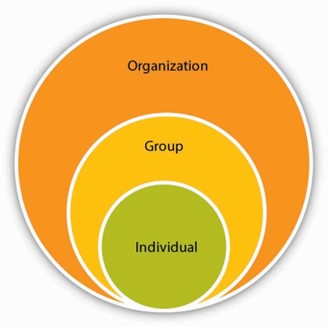
As each workshop is structured in a self-reflective state, the participants will evaluate their behaviors and patterns, and then track these during the course of the following month prior to the next workshop. In this manner they can either validate or refute their prior statements made during the prior workshop, and come to terms with the reality of seeing for themselves how skilled or self-aware they were through daily interactions versus their self-reflection during the workshops.
After the first three months there will be a shift to perform the same assessment in an organizational level, where participants will identify key traits or behaviors that are encouraged or frowned upon in the organization, when they are focused on daily interactions, and professional development for the further advancement of the company.
Once the in-depth assessment and evaluation of the organization is made, then the participants will actively evaluate their behaviors between the workshops, and write down whether and if so, how often did they go with or against their values, behaviors and patterns as individuals, in order to fit within with the organizational culture.
As part of the self-awareness course, individuals must evaluate whether the behavior they took note of was positive or negative, and if it was as a result of the organization and its culture influencing the participants.
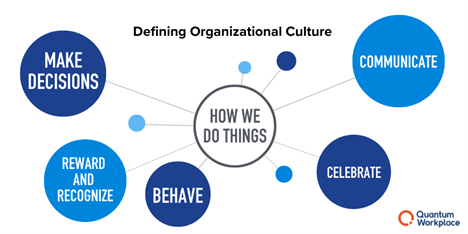 The latter part of the program will then focus on how the individuals can help change the organization and business culture to be more favorable for growth and development, and leverage the skills and behaviors that employees have, in order to further advance the organization, versus preventing employees from expressing themselves openly, in order to encourage creative thinking, progress, and the evolution of the company culture.
The latter part of the program will then focus on how the individuals can help change the organization and business culture to be more favorable for growth and development, and leverage the skills and behaviors that employees have, in order to further advance the organization, versus preventing employees from expressing themselves openly, in order to encourage creative thinking, progress, and the evolution of the company culture.
Company culture and behaviors can impact positively or negatively an individual, either by forcing them to fit into a mold, or to be expelled or cast out because their behaviors aren’t in line with the organizational culture.
Through self-awareness, the participants can evaluate themselves, but also realize that they must take an active part in changing the organization for the better, or let go of limiting or adverse behaviors which are actually damaging the organization, and the employees they interact with on a daily basis.
Industries
This service is primarily available to the following industry sectors:
Aviation
History
Aviation, for large number of years was a service which was only offered to high executives or people with high disposable income. It used to be a luxury to be able to travel around the world weather for pleasure or for business. It was seen as a social elite of being able to travel across the country or the world to meet potential customers, and make presentations as well as close business deals.
As a result, airlines didn’t have to focus as much to differentiate amongst each other for their passengers, as they were very few competitors in the space. Here in the United States, domestic players dominated a large share of the market and passengers were at the mercy of the offering that the airlines would provide. In majority of the cases the industry wasn’t open to free competition as it was very difficult for passengers to identify and compare pricing amongst airlines in order to receive the most favorable deal for their tickets. A large portion of people would purchase tickets through travel, agencies or calling the airlines directly. With a result of the online booking platforms, such as Travelocity and Expedia, this brought more competition into the industry for the airlines, and opened different possibilities for passengers to choose more affordable fares. With this open market this brought more competition and this may airlines reevaluate, heavy, sold to their customers. Online booking platforms also brought foreign carriers into the passenger options, so now passengers could choose to travel on their destination’s airline and potentially travel for a cheaper fare.
Globalization and the Internet had made air travel a very competitive industry.
Current Position
As technology in the Internet evolve, there are now more options for passengers, both for businesses, as well as leisure passengers, with regards to airlines, and options they can use. Purchasing airline tickets can be now considered as à la cart menu, where passengers can choose if they would like to choose their seat beforehand, where they would like to sit, the type of food that they would receive, and the type of baggage allowance that they would receive.
With all these options, there is a large complexity to understand the different pricing points for all types of travel. It is now more difficult to segment passengers. One example of this is work nomads, where, as a result of Covid are now able to work remotely anywhere in the world as long as they have an active Internet connection. These types of individuals might want to be able to check a large bag and have Wi-Fi on board to be able to work and get ahead and no one else to notice that they’re currently traveling outside their home to experience remote working somewhere else in the world.
In the same manner, there can also be individuals who backpackers are simply looking for the cheapest way to get to a destination. Because of this heavily use of technology, it is now more important than ever to empathize and connect with the travelers for beyond what airlines have been doing in the past. One example is how Virgin America a few years ago, created a safety video, which was appealing, interesting, and modern. This broke the traditional way of communicating mundane and repetitive information to now captivated audience. Virgin America created a new airline culture that passengers embraced and loved.
Future Outlook
With the many options passengers have it is now extremely important to focus on how you appeal to your customers on a personal level. There needs to be a deeper connection and establish stronger relationships with passengers, in order to be able to develop a long-term relationship. Airlines need to differentiate themselves in order to establish their own brand in a very commoditized industry.
It’s a very complex relationship of leveraging technology to facilitate process for passengers, but also create a personal and unique experience. Some airlines even leverage technology to be able to address each passenger as they sit in their own seat and buckle up their seat belts.
In addition to this, the personality of all the employees that are working for the airline is critical. We now see more involvement from the people, checking in the passengers, helping them on board, as well as the flight attendants, and the pilots that are having now more conversations with their passengers. All of these interactions add to a richer experience for the passengers, which they will remember the next time that they are purchasing a ticket.
As a result of these constant changes, all airline employees including management must take stronger approach to understanding self-awareness in order to be better able to communicate not only with peers, but with customers. The industry is far more dynamic and self-awareness of how each individual deals with stressful or uncomfortable situations is critical in being able to positively contribute to the organization, as well as the airline’s overall profitability and existence in the airline industry.

Healthcare
In 2010 the Healthcare industry had a large change, driven by the Affordable Care Act (ACA), as it was signed into law, expanding access to health insurance through provisions through healthcare marketplaces, and the expansion of Medicaid.
In conjunction with the Health Care and Education Reconciliation act of 2010 amendment, these pieces of legislature drove the largest regulatory overhaul which expanded coverage since Medicare and Medicaid in the 1960’s.
By 2016 the Affordable Care Act had halved the number of uninsured percentages of the population, accounting for an estimate of up to 24 additional people with health insurance coverage. Insurers were required to accept all applicants without charging based on preexisting conditions or demographic status, with the exception of age.
As a result of increasing healthcare costs high deductible health insurance plans became more prevalent. These however began to decrease with group insurance plans, as corporations are now offering more than minimum coverage to their employees.
US Healthcare spending in 2022 grew to $4.5 trillion, as a result of growth in Medicaid and private health insurance spending. In 2022, a historic high of 92% of the population were insured.
The US government also contributed to the spending growth, as a result of federal funding through the Provider Relief Fund and the Paycheck Protection Program, to support insurers and the population through the COVID-19 pandemic.
As per the Centers for Medicare & Medicaid Services, hospital care accounts for 30% of health spending, which translated to reach $1.4 trillion in 2022.
The second largest category was Physician and Clinical Services, accounting for 20% of health spending, or $884.9 billion.
The third largest category is retail prescription drugs, accounting for 9% of health spending, or $405.9 billion.
With this history and rising healthcare costs, providers must be more aware to differentiate themselves, in order to provide value beyond the required care, in order to retain and grow their patient base.
Current Position
As the population in the United States continues to age, the population considered Gen X (ages 44-59 years old) are continuing to take care of the baby boomer generation, who are now between 60-78 years old. This change brings more pressure for the healthcare industry to support this larger population.
With that said, healthcare providers must leverage technology and other tools to facilitate the caretaking process of their parents. We now see conveniences such as the ability to prepopulate patient intake forms, add allergies and medication information, as well as sync their patient information to their closest pharmacy.
Healthcare providers are also leveraging the use of text messages and mobile applications to encourage communications and share updates in a more proactive manner with their patients.
Technology facilitates the interaction with patients, and creates a closer relationship. Even though COVID-19 created a great deal of pressure for healthcare providers, technologies emerged to support the medical practitioners, by providing new alternatives such as virtual care, and online appointments, thereby reducing the strain of patients having to drive and wait to meet their medical provider. Online consultations are now becoming the norm, with insurance companies providing these benefits to their patients sometimes as a free service part of their monthly healthcare premium.
Another area where added value services are being provided is improving the quality of services and benefits for Medicare patients. Across the United States, specifically in Florida, healthcare providers for Medicare patients are offering more services such as patient pickup and delivery, as well as hosting social events for patients to dance, play games, listen to music, and socialize with other members.
Healthcare services providers must look beyond the transactional approach to healthcare services, and create a stronger bond with their patients and their families. The term “customer” now has a broader definition.
Future Outlook
The future of healthcare must address new challenges, such as labor shortages, the continuous effect of the COVID-19 pandemic, as well as a rise in inflation costs.
According to a McKinsey study in January 2024, healthcare margins are reducing despite the increase in financial performance, compared to pre-pandemic levels.
As a result, healthcare service providers will need to continue implementing transformational efforts, leveraging technology and process improvements, industry consolidation, and revenue diversification to offset the rising costs due to inflation, as well as leverage technology to offset the competitive employment hiring.
Starting from customer facing roles, healthcare providers are now facing high turnovers with front desk staff, and as a result they need to leverage technologies to facilitate the patient intake process, in order for a single front desk staff to be able to support and help multiple patients at the same time.
Laboratory facilities such as LabCorp are now leveraging self-check in machines to enable patients to scan their driver’s license and insurance information, thereby reducing the bottleneck of human interactions.
Clinics are also posting on screens across clinics patient information, with regards to who’s next to be called in, which patients are currently being taken care of. All driven to automate the check-in process, with the goal of minimizing the need for onsite staff to answer questions and support the patients, in an effort to mitigate the high employee turnover.
Lastly healthcare businesses must develop new revenue streams to offset inflation. Two new opportunities being implemented are:
Establishing a parallel premium concierge service: Outpatient health settings are creating a parallel system to take care of their premium patients and their families, providing shorter wait times, as well as the ability to schedule a doctor’s visit within a shorter time frame. In this way healthcare facilities are generating an additional monthly premium revenue.
The second new strategy to be implemented is creating online marketplaces to support their patients and the purchase of medication. One example of an ophthalmology practice in South Florida, is developing an online marketplace for their eye products, and enabling its patients to “subscribe and save” in order to take away that income to local pharmacies, and providing a more premium customer service which includes home delivery, or pickup of the products during their doctor’s visit.
The key point to mention in this section is that both of these strategies seek revenue outside of compensation provided by insurance companies, who, in a broad sense, do not reimburse 100% of the claims filed for medical services provided. These help the healthcare businesses support their cashflow management.
The Healthcare industry must continue to challenge itself, and re-defy its status quo, in order to remain competitive and adapt to the ever-changing landscape.

Technology
History
In the past 20 years technology growth has been primarily driven by leveraging the growth of the internet, and the goal to seek more data to make better businesses decisions, through the development of smart sensors to enable proactive management of manufacturing and production processes.
Some examples in the food consumption industry are the use of sensors which help optimize production, for example in chickens and egg production. By leveraging heat sensors, some aviculturists were able to determine the most optimal temperature within their facilities where hens would congregate to produce eggs, as well as the feed areas that were used more frequently. As a result, they were able to adapt and restructure their entire environment to meet that specific optimum scenario, so that the entire hen population would eat, and congregate evenly across the entire hen tray. This also helped raise the comfort levels of the animals, and increased output as hens were no longer fighting for premium areas.
In the transportation and logistics industry, the use of sensors to measure engine performance, as well as driving behaviors through GPS tracking helped companies restructure their entire maintenance operations to be even more proactive rather than reactive. All of the driver and engine data provided are now helping companies to better manage their vehicle fleet, as well as generate large data sets in to better analyze and study for patterns and behaviors, in order to draw conclusions as to how to optimize the fleet utilization.
Businesses were focused on generating more data to make more rational, evidence-based decisions, and move away from reactive methods for managing their businesses.
Current Position
With the launch of Chat GPT November, 2022, the entire world changed. Artificial and large language models (LLM’s) would change the way we operated in the world, both personally and professionally. Human evolution had been provided a new “Black Swan”. An unexpected event that nobody predicted, and now almost two years later businesses are experiencing exponential growth and change across all industries.
Large language models with chatbot interfaces have accelerated the decision-making processes for businesses. As large company historical datasets are stored in databases, and this information is trained and structured in order to be queried and searched on, businesses have reduced the time taken to gather information and make educated, strategic, fact-based decisions.
AI is revolutionizing the oil and gas industry. One example is in the surface analysis and geological assessments. ExxonMobil seeks to leverage AI powered robots in order to detect oil seeps, which will reduce human exploration risk, as well as reduce marine life harm.
Finance departments are also able to leverage AI to reduce their manual processes and make smarter and faster decisions. As Microsoft and SAP collaborate as integral partners, Microsoft leverages SAP’s ERP software and AI capabilities, and SAP hosts their entire software on Microsoft Azure. Through this strategic partnership, and the use of Artificial Intelligence, customers for SAP and Microsoft can search in a more dynamic manner through financial data.
For example, SAP has developed a chatbot interface where finance managers are able to ask questions pertaining to historical outstanding accounts receivable, and receiving the answer in a conversational chat-like manner through the chatbot interface.
Another example is the ability during the monthly financial close, to ask the AI to find out which vendors are missing to create a cost estimate for, and the AI model will return the vendors and the projected cost amounts for which finance managers must account for, in order to publish and state accurate financial statements. The AI model researches historically through vendors and their monthly expense amounts, and determines based on predetermined parameters what the cost accrual (estimate) should be. A process that used to take 5 days even for large Fortune 500 companies such as American Airlines, can now take 1-2 days by leveraging AI and mass data analysis.
Future Outlook
Technology is advancing at such a rapid pace that businesses across all industries must embrace the new technologies in order to redefine themselves.
Not changing or adapting is not an option. As the data analysis and computing power evolves, businesses must also, in parallel focus on providing a more personal, distinctive experience to their customers.
As part of the quest for large datasets across several areas of a businesses, organizations must leverage that data to better understand their customers, and tailor a more personal experience as to how they communicate and engage with them.
Customers now expect a more personal interaction with large businesses, and companies must create that personal bond or connection, in order to establish long term relationships with customers.
One example of this is how airlines are now leveraging passenger data to push information on the passenger’s seat on the plane, greeting the passenger with their personal name, providing movie suggestions based on their profile, and suggest food alternatives which cater to their food preferences. Consumers all are now seeking for unique experiences, and large corporations must satisfy this requirement.
Lastly the distinction between machines/computers and human beings is disappearing. Machines and computers are now able to provide a more human-like interaction, leveraging chatbots to summarize and consolidate data, providing answers to users in a conversational manner.
Technology is pushing boundaries of what is considered human, as there is now use of AI to even create spoken conversational interactions. Companies can now leverage AI to generate spoken words with specific accents, as well as gender. AI will be able to interact with each other, in order to optimize and in some cases replace humans running key departments in organizations.
The development of technology is a challenge that will push mankind to think in new ways. Leveraging technology to support us to make better and faster decisions will also push the envelope on the status quo of work, corporations, and the broader sense of how the world interacts with each other to engage in commerce. These are very exciting times, as mankind continues to unravel layers to its onion, and uncover new potentials for growth and self-development.
Locations
This service is primarily available within the following locations:

Miami, FL
History
The great diversity in Miami is an abundant fountain of growth and learning. South Florida is a hub for trade from Latin America, the Caribbean, and United States.
To a large part of the population, Miami has been a beacon of hope for people seeking refuge from economic and political crisis. As a result of this influx the city has enriched exponentially, by having this large influx of talent and cultures, all looking to build their own American Dream.
With regards to growth and self-development, this region is a great resource for anyone, wanting to experience different perspectives, and meet different people from several walks of life. There is a vibrant Latin American community, and to do business, you must understand cultures and peculiarities of each nationality.
Miami is known for its construction, travel, leisure, healthcare, and insurance industries. This drives not only internal development, but also disposable income from individuals and their families. Some large corporations based in Miami are Carnival Cruise Lines, AutoNation (car dealerships), Office Depot, Lennar (construction), World Fuel Services (aircraft fuel), and Ryder System (transportation and supply chain).
Another large hedge fund based in Miami is Citadel LLC, a multinational hedge fund and financial services company, which has more than 62 billion assets under management.
With adverse economic factors affecting other Latin American countries, more people and their families have moved to Miami. Foreigners value the United States, and specifically Miami because of its proximity to Central, South America, and the Caribbean. Another common theme is for people and individuals to invest in real estate so that you may appreciate and value and earn passive income through commercial or residential rental activities.
Businessman come to United States to invest in more stable economy and change their local currency to dollars which more than likely more stable.
In addition to this, with high inflation in Latin American Caribbean acquiring properties is it more stable long-term investment here in Miami than other areas of America and the Caribbean.
Current Position
Miami is a major contributor to the economy of Florida. According to the U.S. Bureau of Economic Analysis, the total Gross Domestic Product (GDP) for Miami-Fort Lauderdale-West Palm Beach, FL Metropolitan Statistical Area (MSA) was $483.8 billion in 2022.
This translates to approximately 15.3% of Florida’s GDP 2. The GDP of Miami-Dade County grew by about 11% from 2018 to 2022, adjusted for inflation.
This sets the stage for a city with strong economic potential, having both an influx of human as well as financial capital.
Post COVID-19, and the boom of remote work and freelancing, people, and businesses are relocating to South Florida. This further creates diversity of people in the city. For example, there are more venture capital firms, as well as Americans from other states, such as New York, Massachusetts, and California.
Venture firms have decided to relocate from New York to Miami. Another example is the growth of cryptocurrency, and how Miami is becoming a crypto hub. Combination of venture capitalists and start attracting a different breath of people.
This improves the overall production and efficiencies, now, in a very general term, the Latin American flare of Miami has evolved to meet the expectations of those from the west coast, the northeast of the United States, and other corners of the world.
The city has seen an increase in remote workers, as well as travel nomads setting up a temporary residence in the city.
As per a Macrotrends report, Miami is now the 6th most populated city in the United States, with a population in 2024 of 6.3m, overtaking Atlanta with 6.1m.
Another market that’s been extremely active is the real estate market, both commercial and residential. According to a study, Miami is one of the cities in the United States, with a higher migration into the city from high income earners.
Another reason as to the population influx is due to the state of Florida not having state income taxes, which drives and migration of population onto the state.
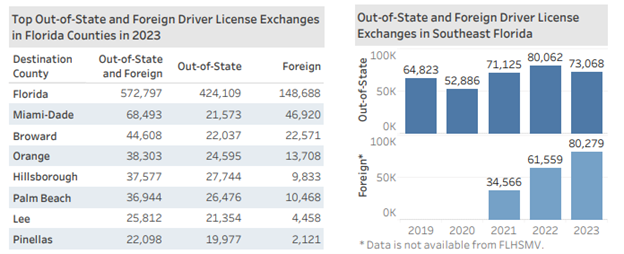
In the graph above provided by the Miami National Association of Realtors, you can clearly see Miami-Dade County being the top out of state county for out of state foreign and Out of State license requests.
As per datausa.io, in 2021, Miami, FL had a population of 441k people with a median age of 39.9 and a median household income of $47,860. Between 2020 and 2021 the population of Miami, FL declined from 461,080 to 440,807, a −4.4% decrease and its median household income grew from $44,268 to $47,860, a 8.11% increase.
The city is transforming, with more affluent and wealthy individuals entering the city, the commerce and services need to adapt and improve their service offerings. The influx of corporations and highly skilled remote workers will be a catalyst for the city to continue evolving.
Future Outlook
Miami and South Florida will continue to evolve in a very rapid pace. The melting pot of cultures and backgrounds is greatly accelerating the development of the region.
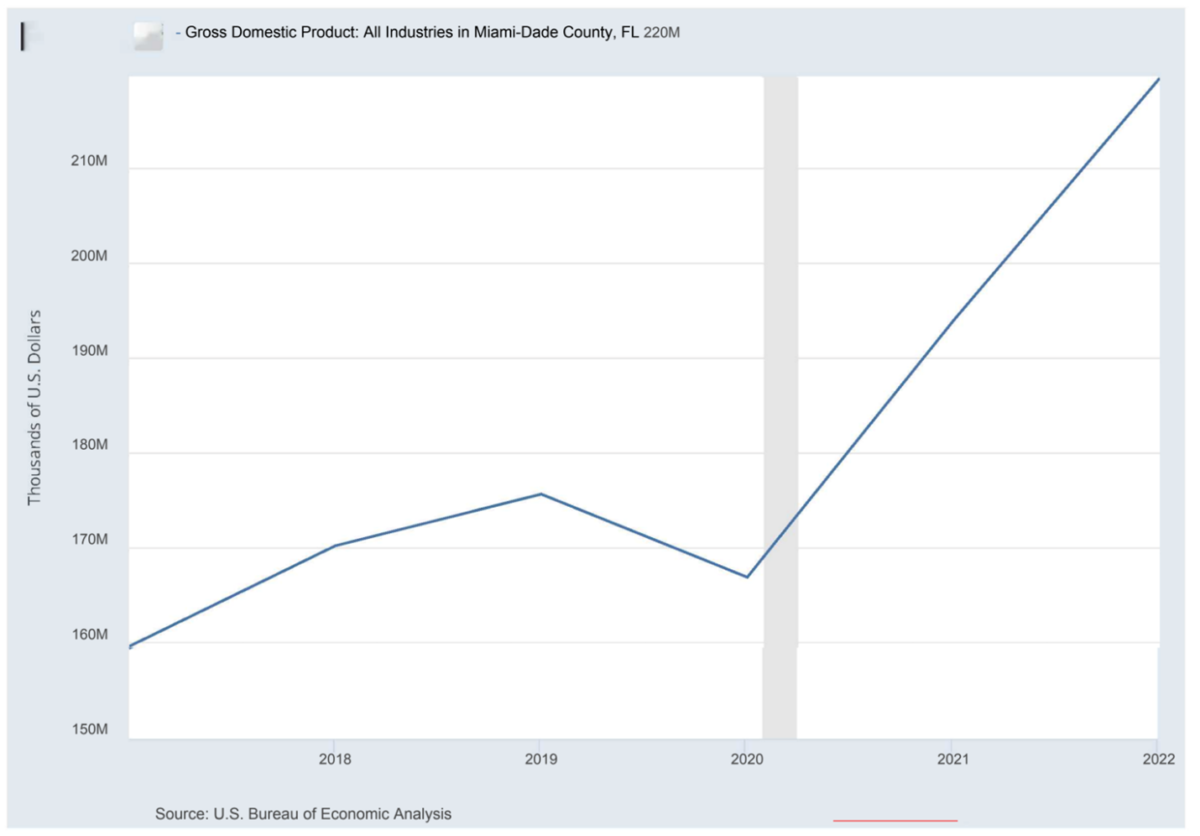
As you can see in the graph above, Miami’s GDP grew exponentially post the COVID-19 pandemic, reaching a GDP of $220M in 2022.
In 2021 the Miami-Dade County launched Thrive 305 Action Plan, the largest public engagement initiative in Miami-Dade County’s history. The focus behind this initiative was to have a government more centered on providing informed decision and communicating effectively with its population.
As a result a countywide survey was answered by over 26,400 residents, which led to large discussions on gathering ideas and planning workshops to convert these into tangible actions the government can take.
The main initiatives of the Action plan are: Create a more accessible county government, Create more engaged and empowered residents, build housing that people can afford, invest in public safety to include prevention, early intervention, reentry, and enforcement.
Other initiatives to note are to broaden and facilitate the transportation options, as well as invest in blue-green jobs that benefit Miami’s water and environment.
The city is also investing in expanding highways, by adding layer expressways to communicate the inland with Miami Beach.
One new project is the Advanced Traffic Management System (ATMS) Project, which includes the upgrade of the County’s ATMS Central Software, the replacement of approximately 3,000 controllers, and installation of additional detection systems at signalized intersections.
There are several large investments also made to the port of Miami, to meet the growing demand of imports and exports to the region, with its neighbor to the north, Fort Lauderdale, also accounting for a large volume of the state’s sea trade route.
There will be a lot of great opportunities for businesses to grow and develop in South Florida. It’s always important to be in a city or place that’s constantly changing and evolving, because that will drive a more challenging environment for both employees and businesses to further develop and grow.
The way of conducting the past will no longer apply 100% of the time. One example is the ability for most people to speak Spanish. Well, that was prevalent in the past that might no longer be the case, considering that most people now have more diverse backgrounds.
Some companies that moved their head offices were Citadel, a leading global financial institution, AerCap, one of the largest aircraft leasing companies, and El Al Israel Airlines, which moved its North American headquarters to South Florida.
This is only the beginning, and the city will continue to develop as one of the most important economic cities in the United States.
Considering large migrations of people from New York, and California into the state it’s going to bring a lot of wealth and development to the region. The city is poised to evolve to a strong capital economy in the United States, outside of its travel and healthcare focus.
Another large impact is natural resources. With the West Coast suffering from draughts and lack of rain due to global warming, Miami with its tropical climate will continue to support the growth and development of the region.
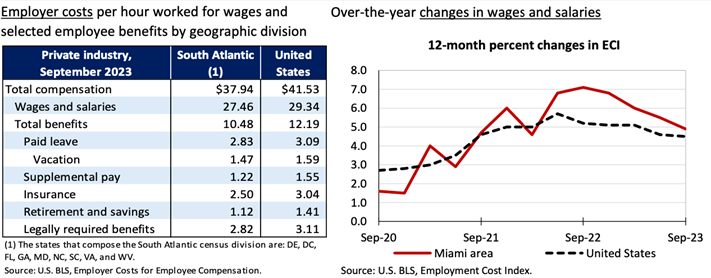
Lastly you can see how Miami has been having larger changes in wages versus the United States, reiterating the more affluent movement of individuals onto the city.

Dallas, TX
History
Dallas has always been one of the most important American cities.
It’s the 3rd largest city in Texas after Houston and Austin, and is the 9th largest city in the US.
Large corporations, such as AT&T, Exxon Mobile, and American Airlines, 7Eleven, and Texas Instruments are based in Dallas. Having companies based out of the city brings a great deal of talent to the market. This brings variety and different types of people from different walks of life.
Having large corporations established in Dallas also brings higher wages, versus a city driven, primarily because of its leisure activities. Being a business, individuals and companies think of the city is a long-term investment and growth opportunity.
Texas is a wealthy state in the US, and neighbors other important cities such as Houston and Austin, further highlighting the key geographical location of Dallas.
In 2022, the GDP of the Dallas-Fort Worth metro area was approximately 592.45 billion US dollars. According to the U.S. Bureau of Economic Analysis, the GDP of the Dallas-Fort Worth-Arlington Metropolitan Statistical Area (MSA) was 688.9 billion US dollars in 2022. The GDP of the Dallas-Fort Worth-Arlington MSA accounted for 3.0% of the total U.S. metropolitan GDP 3.
In addition to the large corporations, with regards to transportation, logistics, Dallas is in the central area of the United States. This translates to being able to be connected to either coast with a 2–3-hour flight.
This helps tremendously as good services can be provided to satisfy the needs of both the east and the West Coast. Without several logistics and transportation companies are based in Dallas to facilitate the movement of goods and people. Dallas is strategic distribution and logistics center.
The city continues to grow evolve, not only leveraging the influx of people from different cities and their backgrounds, but also, they’re closeness to Mexico and companies conducting business in both Dallas and Mexico.
Current Position
Dallas is a leading global wholesale market, being the home for the Dallas Market Center, one of the world’s largest wholesale merchandise complexes. It is also the leading financial and banking center of the Southwest, and according to Britannica, there are over 6,000 companies headquartered in Dallas. Dallas is also the world headquarters to the US Army and Airforce Exchange Service, which provides goods and services to military personnel.
Dallas has one of the largest concentrations of trade and transportation, financial activities, and professional and business services.
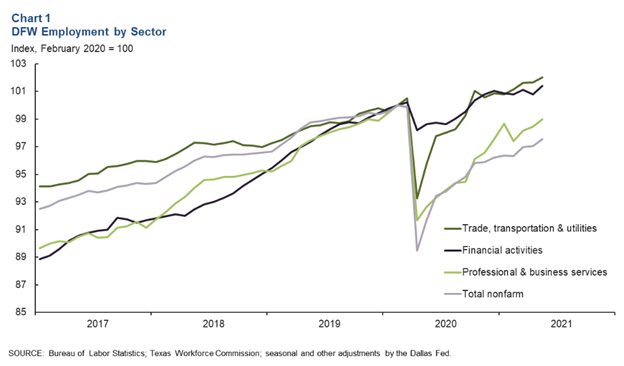
With a recent employment migration, because of COVID-19, remote work has also been growing as people have migrated from states, such as California, New York, and Massachusetts.
With that said, there is a large real estate development growth that’s occurring, as there are several developers building rental condominiums for the large influx of people.
Dallas is now the largest landlocked metropolis in the United States, measuring at close to 9,000 square miles. To put this in perspective, Dallas is bigger than six other states.
Because of the aggressive real estate development, other areas outside of Dallas have now developed into suburban communities that support the daily commute and lives of people working in Dallas. Such areas include Fort Worth, Irvine, and Plano.
In December 2023, Dallas home prices were up 19.7% compared to 2022, selling for a median price of $407K. On average, homes in Dallas sell after 41 days on the market compared to 37 days in 2022. There were 693 homes sold in December 2023, down from 715 last year.
Another strong reason that brings an influx of residents to the city is that Texas doesn’t have state income tax. When markets are changing drastically, and there are difficult decisions to be made, every financial decision that can help you improve your bottom line should be considered.
Currently with the extreme, nonstop competition companies need to adapt and stay lean, and shave costs where possible to remain competitive.
It’s important to note that people are now thinking out of the box, whereas before people would be extremely reluctant to move out of their apartments in Silicon Valley, or in the Upper Eastside in New York.
To leave another perspective on how much Dallas and its metropolitan areas growing we must take into consideration the growth on Fort Worth, Plano, Irvine, and. This is a city that’s also growing because of the migration into Dallas.
Future Outlook
In 2023 Dallas won the global award for Smart Cities initiatives, which recognizes 50 cities around the world for innovative and influential work related to smart cities projects and initiatives.
The city won the award for its work on the Red Cloud Neighborhood Smart Cities pilot program, which provided community Wi-Fi to almost 190 homes. There were also Air Quality Environmental Monitors, as well as AI-enabled situational awareness cameras at select locations. These initiatives will help the city further enhance infrastructure planning and public safety.
As the world evolves, people believe more in the improvement of their quality of life. That side and leveraging the advantages of technology, people are more willing to work in suburban areas where they can afford more land.
In such cases, Texas comes to mind specifically Austin, Houston, and Dallas. These are all cities that have lower cost-of-living expenses than other large metropolitan areas in the United States.
Dallas is a wealthy city, and it attracts highly qualified competent people to the area.
Based on Texas Real Estate Research Center, the average sales prices for residential properties increased 1.86% YoY to $483,346, further underlining the trend towards pricier properties.
As the demand for housing increases, in addition to the limit in inventory, this translates to the potential of real estate price increases, which will have an impact on the lower income classes residing in Dallas.
As more people embrace the remote work mindset, prices will continue to increase in Dallas. Also invented of having corporations headquartered in Dallas is that it brings a lot more jobs for qualified people versus other states or cities that more rural growth.
A reality is holding through because of our political landscape, is that red states are developing further than blue states. Red states want to focus more on driving growth and supporting businesses, which help keep the attention of business owners, and start up entrepreneurs.
The future growth of Dallas appears promising as it aligns with evolving trends in people’s preferences and the changing nature of work. With an increasing belief in enhancing the quality of life, individuals are showing a greater inclination to work in suburban areas where they can enjoy more affordable land. Texas, including major cities like Austin, Houston, and Dallas, stands out as a prime destination due to its comparatively lower cost of living when compared to other major metropolitan areas in the United States.
Dallas, in particular, benefits from a positive business mindset and a reputation for success. Areas like Uptown and Highland Park exude luxury, reflecting the city’s affluence and attractiveness to highly qualified professionals. As the global workforce embraces the remote work mindset, Dallas is poised to experience continued growth, translating into an increase in property prices.
The presence of corporate headquarters in Dallas further amplifies its growth potential, bringing with it a wealth of job opportunities for qualified individuals. This economic magnetism contributes to Dallas standing out among states and cities, particularly those experiencing more rural growth. Notably, the political landscape plays a role, with red states like Texas focusing on driving growth and supporting businesses. This approach has proven effective in capturing the attention of business owners and startup entrepreneurs, positioning Dallas for sustained development in comparison to some blue states.
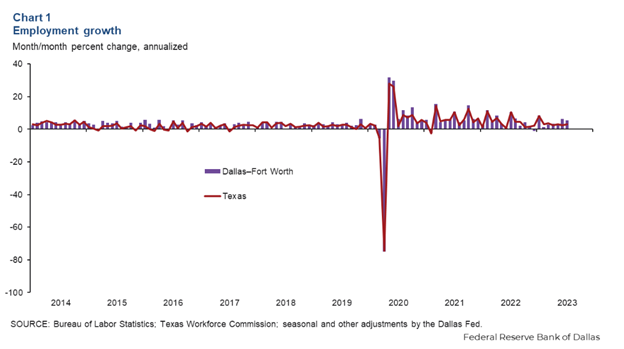
In a study conducted by the Federal Reserve Bank of Dallas, we see clearly how there is positive employment growth post COVID 19. This further emphasizes the growth the city is taking.
We can also see this below in the Dallas-Fort Worth Hourly Rate of $34.34, above the national average of $33.60, and the state of $31.34.

In essence, Dallas’s future growth trajectory is influenced by a combination of factors such as its affordability, positive business environment, and the shift towards remote work. The city’s wealth, coupled with a pro-business stance, positions it as a magnet for talent and economic activity, making it a key player in the ongoing trend of red states driving significant development.

Mumbai, India
History
Mumbai is the business capital of India and stands as one of the strongest cities for business development and investment. The city and its surroundings are the second most densely populated city in the world.
The city began growing as a result of its strategic location past the Suez canal, and as a result it had developed into a key economic region.
Mumbai is also connected throughout the rest of India through the country’s extensive rail infrastructure.
The city evolved tremendously, with a large population inflow from other areas of the country looking for business opportunities and wealth.
With a thriving country workforce large international companies established offices in Mumbai. One of them is Reliance Industries, which is an Indian conglomerate that includes businesses in energy, petrochemicals, natural gas, and telecommunications.
Because of this thriving growth, the city has experienced rapid urbanization, and infrastructure development. The real estate sector has grown extensively, which brought new challenges such as traffic congestion, and insufficient public infrastructure.
There are now several skyscrapers, and Mumbai’s Financial district, the Bandra Kurla Complex (BKC) has emerged as the business hub of the city.
In addition to corporations establishing presence in the city, the cultural scene has also grown, with the development of Bollywood, literature, and art.
Mumbai seems to have it all and something for everyone. The interesting melting pot of cultures and backgrounds create a fertile soil for individuals to come together and make something greater of themselves.
Current Position
As of 2021 Mumbai’s Metro Nominal GDP is estimated to be $277.98B. As a result, Mumbai is the richest Indian city, and the 12th richest city in the world.
Mumbai accounts for over 6% of India’s economy.
Some businesses established in Mumbai are the Bombay Stock Exchange, The Reserve Bank of India, the Tata Group ($103B revenue), Essel Group, and Reliance Industries ($75B revenue). It is said there are 46,000 millionaires, and 48 billionaires living in Mumbai.
Mumbai accounts for 25% of the total industrial production, 70% of Indian maritime trade, and 70% of capital transactions to the Indian economy. These statistics come from the Indian Marine Federation.
The city is also known for its gems and jewelry. Mumbai receives a large part of the country’s gold and rough diamond imports and is also the largest exporter of gems and jewelry, which translates to $28.32B.
As India has grown to be an even stronger player in the world economy, people have come to realize the Indian strong work ethic, and drive for success. With that said, for people to grow and develop they must migrate to the larger cities in India, to further develop their skills and their professional career.
Mumbai is a city where businessmen can establish strong business connections to further develop and grow their businesses. By being the richest city in India, it also attracts international firms, real estate investments, and capital.
The city is investing in the development of the metro, to improve daily transportation to its people. With technology and manufacturing leading industries in the global markets, more multinationals are establishing a presence in India, to be more connected to the growing human capital pulse. The city is building a new airport and is building them in a phased approach. The new airport is named the Navi Mumbai International Airport.
Future Outlook
Mumbai will continue to remain the center of the Indian economy, and it is investing heavily in infrastructure projects to meet that growing demand and requirements by its residents.
image too small
In a study conducted by Cushman & Wakefield, 2024 is poised to have a new supply of office real estate higher than the Net Absorption of current supply. Cushman & Wakefield also project a decrease in overall vacancy below 20%.
Below you will find other key lease transactions identified in the Cushman & Wakefield report.
image too small
Below you will also find statistics on the YoY growth projections in the residential industry. There is growth both in the Rental and Capital values of residential real estate.
image too small
As part of its infrastructure investments there is a need to expand and provide better real estate and urbanization. Because of the large population, and the population density, Mumbai must invest heavily in urban planning, infrastructure redevelopment, and leveraging satellite cities to complement the large Mumbai metropolitan area.
With regards to the industrial infrastructure, we see in several submarkets YoY growth with regards to warehouse rent, and YoY growth regarding land rates for industrial purpose.
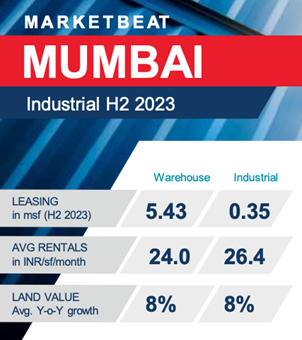
To improve transportation, the city will invest in an 8-lane highway bordering the ocean, which will help with the bottlenecks of entering and exiting the city from the South, and improve communications to the north, closer to Andheri, where the airports are located.
In addition, there is the Mumbai metro project. The Mumbai metro will have 14 metro lines which extend over 217 miles and will cover every corner of the city.
These two projects will help develop areas of the city to invest in more desired homes with modern amenities, as well as proximity to the metro stations.
One recent accomplishment was the inauguration of the Mumbai Trans Harbor Link on January 12th, 2024. This is considered an engineering megastructure. The bridge spans for over 13 miles and will link Mumbai to the mainland Navi Mumbai.
As India became the most populous country in 2023, it brings a lot of attention to Mumbai, and its ability to set itself apart as a pivotal financial and tech sector for years to come.
All the projects highlighted above, will further enhance the value proposition that Mumbai offers as a business hub, able to service the evolving needs of its entrepreneurial and executive residents.
Program Benefits
Management
- Enhanced Efficiency
- Clear Vision
- Organizational Alignment
- Active Listening
- Adaptability
- Self-Reflection
- Growth Mindset
- Effective Leadership
- Empowering Feedback
- Legacy Development
Operations
- Efficiency Boost
- Communication Channels
- Collaborative Synergy
- Coordination Improvement
- Adaptive Flexibility
- Process Improvement
- Leadership Development
- Growth Mindset
- Feedback Culture
- Resource Optimization
Customer Service
- Customer Satisfaction
- Improved Retention
- Issue Resolution
- Positive Brand Image
- Empathetic Communication
- Conflict Resolution
- Knowledge sharing
- Crisis Management
- Team Collaboration
- Continuous Learning
Testimonials

Testimonial 1
Content here…

Testimonial 2
Content here…

Testimonial 3
Content here…

Testimonial 4
Content here…

Testimonial 5
Content here…
More detailed achievements, references and testimonials are confidentially available to clients upon request.
Client Telephone Conference (CTC)
If you have any questions or if you would like to arrange a Client Telephone Conference (CTC) to discuss this particular Unique Consulting Service Proposition (UCSP) in more detail, please CLICK HERE.








